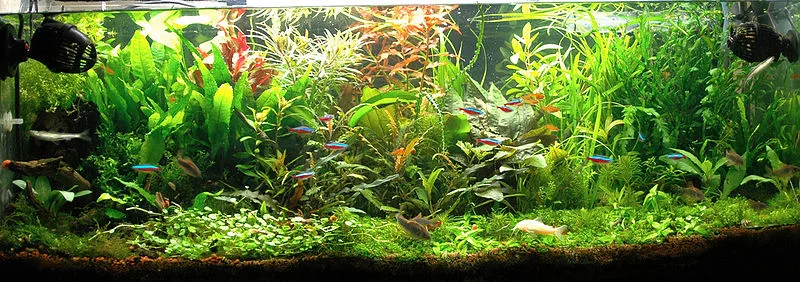
Why is a planted aquarium important to have?
A freshwater planted aquarium represents a distinctive and authentic aquatic ecosystem that can be established within the confines of your home. Planted or natural aquariums encompass a thoughtfully chosen selection of aquatic plants and fish, meticulously designed to accurately replicate the captivating underwater environments found in nature. These captivating aquariums have gained recognition among gardeners, educators, and experienced aquarists alike, who have come to appreciate the numerous advantages they offer.
Due to the mutually beneficial relationship between fish and plants, maintaining a well-established natural aquarium generally proves to be less challenging compared to other aquarium setups. The fish contribute essential elements such as carbon dioxide and nutrients, which promote healthy growth in the aquatic plants. In return, the plants provide supplementary biological filtration and oxygen, establishing a pristine and nourishing habitat for the fish.
Whether you are a novice in the realm of planted aquariums or a seasoned enthusiast, you are bound to revel in the enchanting allure of this distinctive aquarium. Join us as we embark on a journey to transform a 20-gallon high (20H) aquarium into a visually stunning natural haven, replete with easy-to-cultivate aquatic plants and tranquil community fish.
What do I need to start a planted aquarium?
Commence by acquiring a 20-gallon high aquarium, an accompanying aquarium stand, and a proficiently designed LED strip light.
Recommended aquarium equipment:
- High-capacity Filtration System
- 100W Submersible Heating Unit
- Coralife Digital Thermometer with Precision Readings
- Premium Substrate for Optimal Growth in Planted Aquariums
- Advanced Freshwater LED Lighting Solution
- Trio of Handpicked Driftwood Pieces
- Comprehensive Water Test Kits for Accurate Analysis
- 250 ml Seachem Flourish™ Excel, a Top-Quality Aquatic Plant Supplement
What plants do I need for a planted aquarium?
- Three (3) Anubias barteri
- Six (6) Anubias nana
- Six (6) Cryptocoryne
- Four (4) Micro Sword
- Four (4) Wisteria
- Three (3) Java Fern
- One (1) Green Myrio
- Two (2) Ludwigia
- Two (2) Rotala Indica
Alternatively, you can consider the following pre-selected plant pack:
- Pre-Selected Plant Packl (Contents listed above)
What fish do I need for a planted aquarium?
- Cardinal Tetras
- Rummynose Tetras
- Albino Aeneus Cory Cats
- Neon Blue Dwarf Gourami
- Shrimp
- Guppy
- Angelfish
- Neon Tetra
- Corydora Catfish
Step 1: Set-up and Start with Quality Plant Substrates
- Arrange the aquarium and stand.
- Introduce a superior quality, mineral-rich substrate (essential for long-term viability).
- Thoroughly rinse the plant substrate prior to placement in the aquarium.
- Fill the aquarium with dechlorinated water and proceed to install the filter and heater.
Step 2: Test and Regulate pH Levels and Hardness (KH)
- Depending on the source water, utilize a water conditioner such as Seachem Acid Buffer or Seachem Neutral Regulator to adjust the pH level within the range of 6.5 to 7.5. It is important to maintain this pH range as it is suitable for both fish and plants.
- Regularly monitor the pH levels of the aquarium once it has been established to ensure proper maintenance.
- In regions where water hardness is considerably high, it is recommended to employ Reverse Osmosis water and subsequently remineralize it using Seachem Equilibrium. This approach helps address the issue of excessive water hardness effectively.
Step 3: Add Light Fixtures
- The utilization of a standard fluorescent lamp, which is typically included with an aquarium hood or strip light, is suboptimal for promoting healthy plant growth within an aquarium.
- To ensure optimal conditions for plant growth, it is recommended to replace the provided fluorescent lamp with a specialized plant lamp. In the case of plants with higher light requirements, it may be necessary to utilize two strip lights to meet their needs.
Step 4: Add Aquatic Plants
- Ensure the aquarium has been properly established for a minimum of 2 to 3 weeks before introducing any fish.
- Arrange short plants in the foreground of the aquarium, and gradually add plants in ascending order to populate the midground and background areas.
Step 5: Add Fish
- Ensure the aquarium is allowed to establish for a minimum duration of 2 to 3 weeks before introducing any fish.
- It is advisable to maintain a school of 6 to 12 small fish in order to create a harmonious environment within natural aquariums. It is important to bear in mind that the plants play a pivotal role as the focal point in a natural aquarium.
- While our list of recommended fish species can serve as a valuable reference, the majority of community fish are well-suited for a planted aquarium.
Step 6: Add Supplementary Plant Nutrients as Needed
- As aquatic plants undergo development, it becomes necessary to provide them with supplementary nutrients (fertilization) to sustain their growth.
- Carbon, being a crucial plant nutrient, is rapidly consumed by growing plants. It is essential to meticulously adhere to the manufacturer’s recommendations in order to ensure the maintenance of healthy plant growth.